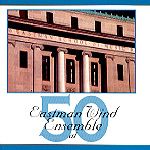As with the uniquely American choral tradition embodied in choirs such as St. Olaf’s and Westminster, so does the Eastman Wind Ensemble represent the “pioneering force” in the “symphonic wind band movement” that began with visionary (and very determined) conductor Frederick Fennell in the early 1950s when he founded this illustrious and ongoing group, headed for the past 37 years by Donald Hunsberger. Long-standing fans may justifiably argue that this 3-CD tribute doesn’t fully represent the EWE’s best work–that is found on the ensemble’s several classic Mercury Living Presence recordings from the 1950s and ‘60s, including the sensational disc of Circus Marches (titled “Screamers”), a collection of pieces by Grainger, Persichetti, Khachaturian, and others, and another featuring Hovhaness’ Symphony No. 3. Nevertheless, this decidedly mixed bag of everything from Mozart to Gershwin to relatively unknown modern composers such as Verne Reynolds and Anthony Iannaccone provides a more than convincing account of why this ensemble remains one of the world’s top wind bands.
The Robert Rumbelow orchestration of Mozart’s Clarinet Concerto (superbly performed on basset clarinet by Larry Combs) is certainly colorful, but the beloved Adagio movement just doesn’t sing–it’s too square, missing the seductively undulating legato in the accompaniment that only real strings can create. The following Last Scenes for Solo Horn and Wind Ensemble, by American horn player/composer Verne Reynolds, seems sincerely indebted to Britten’s solo horn passages in his Serenade (there’s even a little glissando near the work’s end), but after the opening minutes it loses momentum and interest. After six of its 12 minutes, see if your attention doesn’t begin to wander. Likewise, Reynolds’ Piano Concerto blasts and blusters but doesn’t have enough big ideas to support the outward show. Besides, the recording makes the piano–the star of the piece–sound weak, its expected robust tones merely clinky and tinny with no body or depth.
Disc 2 more than makes up for the disappointment of Disc 1, beginning with Anthony Iannaccone’s dynamic, atmospheric, and masterfully scored Sea Drift, followed by Kent Kennan’s idiomatic and thoroughly engaging Trumpet Sonata. Both of these works keep your interest by offering well-defined ideas, appealing melodic material, thoroughly developed thematic material, and superb playing by the entire ensemble. The two Prokofiev marches (Op. 69 No. 1 and Op. 99) recall the earlier glory days of the EWE, with infectious rhythmic spirit, rousing percussion, and gorgeous-toned brass, all balanced to perfection.
Disc 3’s Gershwin and Weill tributes, arranged by EWE conductor Hunsberger, are outstanding, both for their evocation of the spirit and style of these two musical geniuses and for the effectiveness of the orchestrations. Soprano Nicole Cabell and baritone Daniel Spiotta are mostly fine in their renditions of several Weill and Gershwin songs (including a gorgeous “Bess, you is my woman now” duet, tempered by Cabell’s somewhat stilted “Summertime”), but the recording–from a concert in Tokyo in June, 2000–unnaturally isolates the voices from the orchestra and gives the whole thing an acoustic character that sounds more like a small studio than a big concert hall. Nevertheless, the ensemble is in top form, technically flawless and totally involved in the music’s sumptuous colors and razzle-dazzle jazz influences. The varied locations and dates make for some expected differences in sonic quality and perspective, but these are minor. Eastman Wind Ensemble fans will certainly want this, and others who want to see what the fuss is about won’t be disappointed. Here’s to another 50 years!
































